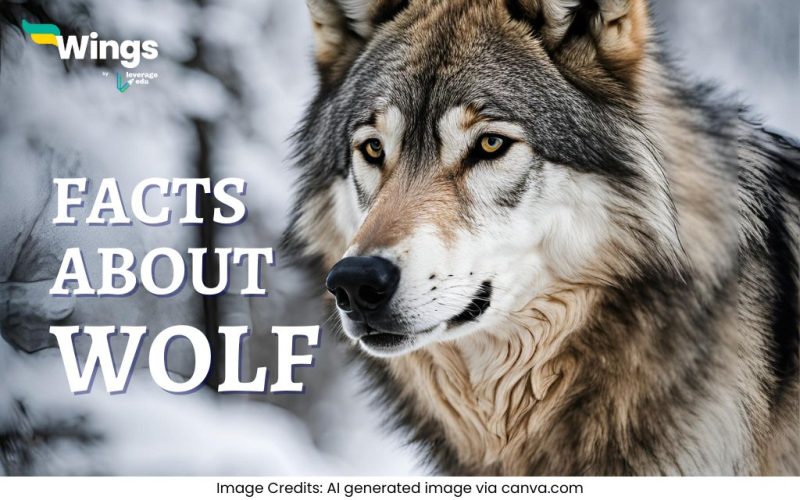Facts about wolves are as fascinating as the animals themselves! Wolves are highly social creatures known for their loyalty to their pack and their spine-tingling howls. They play a crucial role in maintaining balance in their ecosystems by controlling prey populations. With their sharp intelligence, excellent hunting skills, and unique communication methods, wolves are among the most admired animals in the wild. Did you know that wolves have giant hands as large as an adult human hand? Here are some more interesting facts about wolf for students to increase their general knowledge.
| Particulars | Facts about Wolf |
| Average weight | Females: 60-80 pounds Males: 70 to 110 pounds |
| Average length | Females: 4.5 – 6 feet Males: 5 – 6.5 feet |
| Average height | 26 – 32 inches |
| Fur colour | Grey, white, or black |
| Total teeth | 42 |
| Diet | Elk, deer, bison, beavers, and rabbits |
| Pack size | 2-30 members |
| Predators | Polar bears, grizzly bears, black bears, and Siberian tigers |
| Average speed | 36 – 38 miles per hour |
| Average lifespan | In the wild: 13 years In captivity: 16 years |
Table of Contents [show]
Interesting Facts About Wolf – Partners, Speed, and More
Let’s explore some interesting facts about wolves that highlight their unique abilities and their essential role in maintaining ecological balance.
1. Wolves Stay Loyal to Their Partners
Wolves are known for their lifelong loyalty to their mates. Once a wolf finds a partner, they stick together through thick and thin, often until death. In a pack, it’s usually the alpha male and female that breed, while other adults help raise the pups, ensuring their survival.
2. Wolves Protect Their Pack at Any Cost
Wolves form deep bonds with their pack members, often putting the group’s survival above their own lives. They have been known to sacrifice themselves to protect their family, showcasing incredible loyalty and selflessness.
3. Wolves Howl to Communicate
Wolves howl to communicate with their pack and other packs around their territory. It helps them locate each other or signal danger. Moreover, howling helps them gauge the size and strength of rival packs, deciding whether to stand their ground or avoid a fight.

4. The Average Speed of Wolves 36-38 Miles Per Hour
With lengths of up to 6.5 feet, wolves are designed for agility. They can sprint at speeds of 36-38 mph when chasing prey. However, during regular travel, they conserve energy by moving at a steady pace of about 5 mph.
5. Wolves Use Endurance than Speed
Unlike many other animals, wolves rely on endurance rather than speed. They can track and stalk prey for hours, using their sharp hearing and keen sense of smell. This persistence, combined with their intelligence, makes them effective hunters even over long distances.
6. Wolves Eat in Hierarchy
Did you know that wolves can consume up to 9 kg of food in a single sitting? The alpha male eats first, followed by others, to ensure the pack’s hierarchy and strength are maintained during times of scarcity.
7. Wolves have Giant Paws
A wolf’s paw can measure as large as an adult human hand. It can be about 4 inches wide and 5 inches long. These massive paws help them travel across snow, mud, and rough terrain with ease, giving them an edge in their environment.

8. Wolves Live in Huge Territories
Wolves roam over large territories, ranging from 25 square miles in populated areas to 1,000 square miles in remote regions like Alaska. Their expansive range ensures access to sufficient food and space to thrive as social animals.
9. Wolves Use Their Dens for Multiple Uses
Wolves often repurpose burrows abandoned by other animals to find shelter and raise their young. They also use natural formations like rock crevices and tree hollows. These dens can be surprisingly expansive, with tunnels extending up to 13 feet underground and sometimes featuring multiple entrances.

10. Wolves Use Different Communication Methods
Beyond howling, wolves communicate using a combination of vocalizations, body language, and scent marking. These methods help maintain pack unity, establish territory, and coordinate during hunts.
11. Wolves are Low Risk to Humans
Contrary to popular belief, wolves pose minimal threat to humans. Documented wolf-human encounters are rare, and even fewer result in significant injuries, debunking myths about their danger to people.
FAQs on Wolf Facts
5 interesting facts about wolves include that they stay together with their partners for life, they are low risk to humans, they howl to communicate with other packs, their average speed is 36 – 38 miles per hour, and lastly, wolves use endurance rather than speed to hunt their prey down.
There are many unique facts about wolves. For instance, they form lifelong pair bonds, forming tight family units within packs. Though they may leave their packs as adults, they rarely live alone for long, relying on their pack for survival and hunting success.
A wolf has 42 teeth including 20 in the upper jaw and 22 in the lower jaw. These include incisors, canines, premolars, and molars, specially adapted for gripping, tearing, and chewing prey efficiently.
Wolves are renowned for their eerie, spine-chilling howls, used for communication. Lone wolves howl to reunite with their pack, while group howls mark territory or warn other packs to stay away.
Wolves rely heavily on their pack for hunting and survival. Isolation, injury, or lack of food are significant weaknesses that can compromise their ability to survive in the wild.
A wolf’s iconic howl is its most special feature. It’s used for communication within packs and to interact with other packs, making it an essential survival and social tool.
Wolves benefit ecosystems by controlling prey populations and reducing overgrazing. Their presence maintains balance in predator-prey relationships and even impacts vegetation and landscape health positively.
Wolves can run up to 36 – 38 miles per hour. They rely on endurance rather than speed.
Wolf’s teeth include incisors, premolars, molars, and their powerful canines, often called fangs. They have a total of 42 teeth.
Huskies are not wolves but share a close genetic relationship. They are domesticated dogs bred for endurance and sledging, retaining some physical and behavioural traits similar to their wild ancestors.
Interesting Reads
Hope you enjoy reading these facts about wolf for students. If you want to know more about topics like this, then visit our Interesting Facts and General Knowledge page!
 One app for all your study abroad needs
One app for all your study abroad needs















 45,000+ students trusted us with their dreams. Take the first step today!
45,000+ students trusted us with their dreams. Take the first step today!
